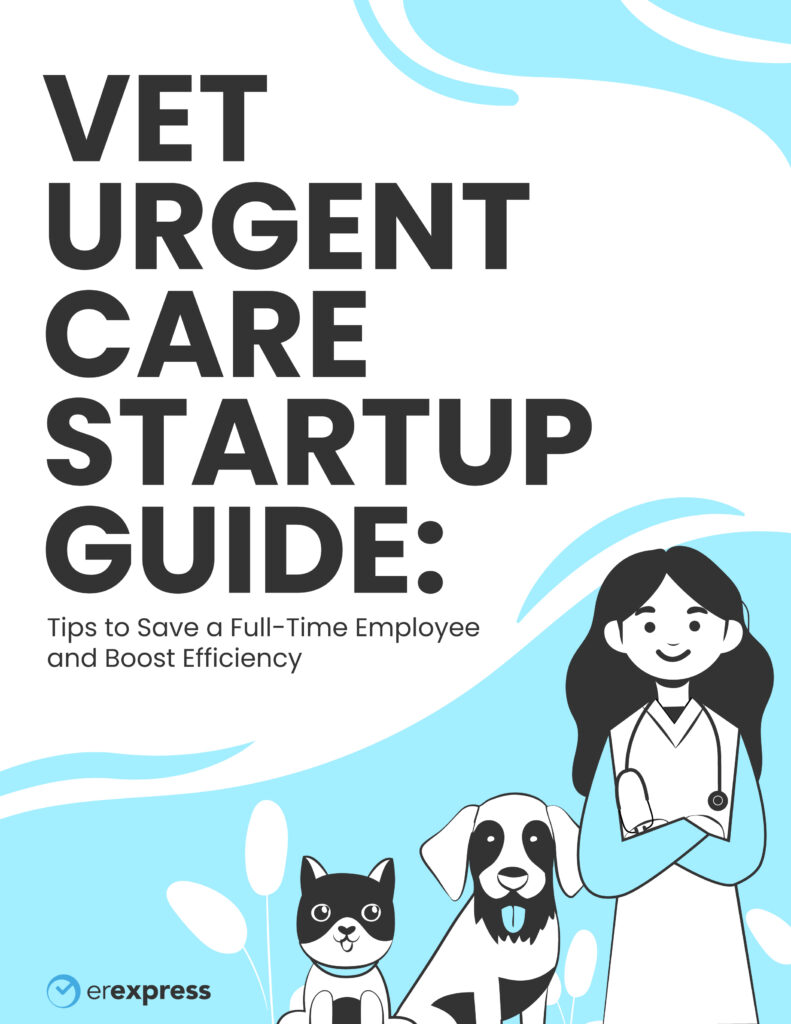
Tips to Save a Full-Time Employee and Boost Efficiency. Download your guide today!
Enter your name and email below to discover how you can meet a growing demand and improve pet owner satisfaction.
Contactless patient intake digitizes the workflow that enables patients to check in for scheduled and walk-in visits at veterinary ERs, urgent care clinics, and hospital emergency centers using their own devices from their homes, cars, or any other location.
The COVID-19 pandemic changed patient check-in from a matter of convenience to one of safety. Safety protocols combined with multiple surges in transmission rates have heightened the need to collect patients’ signatures, demographic information, ID and insurance images via digital devices instead of pre-pandemic norms that often relied on manual, in-person workflows.
In addition to reducing potential virus exposure for both patients and staff, staff needed ways to quickly collect this information without relying on phone calls.
Though we are now largely living in a post-pandemic world, many of these features have remained fixtures in medical facilities. For example, wearing a face mask in urgent cares and ERs is still commonplace and many patients continue to appreciate the convenience of cutting down time spent in the waiting room and filling out digital intake forms from a more comfortable location.
On a practical level, this makes sense for medical organizations. By continuing some of the safety measures introduced during COVID-19’s peak, you can also potentially help prevent the transmission of other airborne illnesses and place less administrative burden on your staff by having them manage intake paperwork manually.
Today, there are still three primary benefits that providers can enjoy from continuing to use contactless patient intake, including:
Intake encompasses everything that staff needs to collect before the visit, including:
Anytime a community experiences a common health condition, like during flu season, call volumes and demand for services also increase. Typically, call volume spikes as patients call for information about hours, appointment availability, test results and wait times.
However, the largest driver of call volume comes from the need to remotely collect intake information, via phone call. Each patient typically triggers one to two inbound calls, plus two to three outbound calls.
Each of these calls last five to seven minutes on average, with some urgent care clinics receiving 30 inbound registration calls in the first 10 minutes of the day. In turn, time spent fielding calls means more time away from other aspects of your operations and serving patients presently at your facility.
Digital contactless patient intake immediately reduces this call volume by enabling patients to submit all of their intake information from their mobile device or in-lobby tablet or kiosk. Many clinics push this process further upstream to have patients complete their intake at home.
You don’t have to take what we’re saying at face-value, though. Learn more about how an animal hospital was able to successfully eliminate five phone calls per visit using ER Express.
Picture this: an urgent care clinic opens at 8:00 am and has twenty patients already at the door. Signage directs them to call the front desk to register. The clinic staffs two phone lines and can register a patient in five minutes on average.
Guess what time the 20th patient gets registered? Probably not until almost 9:00 am! This phenomenon, sometimes dubbed “a line just to get in line,” can add 30% to the average length of staff.
However, contactless patient intake vastly reduces the intake time because it enables almost unlimited simultaneous, parallel registration. Reimagine the above scenario: twenty patients all start filling in their intake information from their phones.
While some patients will complete it faster than others (depending on whether they have visited before, need to update their insurance, etc.), all 20 will get registered by 8:10 am. Staff can review, triage, and prioritize all twenty patients. They can spot the patient presenting with shortness of breath or the dog that ate chocolate immediately.
As a result, patients with more urgent medical needs can be treated more quickly than others who may just be visiting for a minor complaint. By prioritizing patients based on need, you can more efficiently move them through treatment and more accurately allocate the appropriate resources to do so.
This isn’t just a hypothetical scenario. With the right solutions in place, it’s achievable. One urgent care clinic measured 30% shorter throughput times after it implemented contactless patient intake.
Manual intake consumes front office staff efforts on data entry related activities. This can include tasks such as verbally getting information from the patient, typing it into the practice management system, scanning insurance cards, and then uploading those images, etc.
Additionally, they spend time answering the same set of questions related to managing patients’ expectations, most often around wait times. With a contactless, digital system, you can proactively provide answers to these frequently asked questions and set accurate expectations for patients that are considering visiting your practice.
As an added benefit, contactless patient intake removes 80-90% of the data entry. Staff can reallocate their time toward more valuable activities such as verifying eligibility insurance, collecting payment, or helping patients with unique circumstances (out-of-towners, out-of-network benefits, etc.).
In addition, contactless intake can include text message updates that give patients answers about why they can expect to wait longer than normal as well as how many patients have signed in ahead of them. This transparency enables them to make more-informed decisions about when to plan their visit so that they can have a more enjoyable experience that better suits their preferences.
Virtual queuing and automated texts, as part of contactless patient intake, delivers all these benefits without the challenges of posting wait times. Your staff will not have to manage any of the communication directly, enabling them to spend more of their time focused on more impactful aspects of their roles at your animal emergency department, urgent care, or ER.
At ER Express, we support animal health practices, urgent cares, and emergency departments with innovative patient engagement and digital intake software, enabling you to offload many recurring administrative tasks and simultaneously manage patient expectations. Learn more about how ER Express supports contactless check-in workflows, including at-home and car check-in.
A quick Google Search will show an overwhelming number of articles (“hospital wait times” showed 1.4 billion results) on healthcare wait times, how to reduce them, publish them, and/or use them as part of a marketing strategy. It’s no wonder then that as most emergency departments, urgent cares and other walk-in clinics see their competitors advertising their wait times via billboard, website or SMS message, they feel a strong impetus to follow suit.
One significant concern that arises from this trend is the potential stress and anxiety it could cause among patients. When individuals are unwell, they’re already in a vulnerable state.
Adding the unpredictability of wait times could exacerbate their stress levels, particularly if there is a long wait ahead. This emotional strain, in turn, might even negatively impact their overall recovery and perception of care.
This impetus assumes that by posting wait times, patients will choose the facility that offers this degree of transparency over another that does not. While this may be true, let’s take a step back and consider what posting wait times online really accomplishes.
Before implementing any strategy, understanding patient concerns and expectations is crucial. This doesn’t mean they necessarily want them posted online, but they want some form of communication about it. By understanding this need, healthcare systems can address it more effectively.
Varying definitions of wait time rarely match what patients expect
First of all, what do patients think “wait time” means? The definitions of wait time vary widely from one health system to another. Consider for example, these common definitions:
Definition #1 would likely result in very short wait times. Under this definition, staff immediately triage patients but send them back out to the waiting room again until a bed is available, making it look like the wait time is quite short but really, patients will still wait longer than they anticipated. On the extreme end, definition #4 most likely presents a much longer wait than what patients have in mind.
Wait times suffer from low accuracy
Many health systems use completely different methods for updating the wait times, such as taking an average over several hours and posting once every half hour or so, while another facility may just post yesterday’s average or a historical average. There are also plenty of health system websites that rely on staff updating the wait time – staff who are busy and are more likely to inflate the number to decrease their workload.
Wait times change rapidly
Consider that even real-time wait times posted online are not the same as the wait times a patient will experience once they arrive. A patient who sees a posted wait time of 15 minutes may head over straight away only to find out that by the time they get there the wait time has increased. The opposite situation may also be true. Patients may pass over the facility with a wait time they perceive as being too long, even though the busyness could clear up by the time they get there.
Wait times can make you look bad in comparison
On that note, in some cases patients will pass up the busiest location if you have more than one where wait times are posted and choose a location with more capacity to treat them. However, they may just decide to skip it altogether and pick a competitor with lower advertised wait times. That competitor may have a completely different definition of wait times that is more easily kept low, even if the actual throughput time is longer. Your posted wait times still can make you look bad in comparison.
Moreover, the focus on wait times might shift the attention away from the quality of care provided. Patients could make choices based solely on waiting, potentially compromising the medical attention they receive. It could lead to an environment where medical facilities are seen as ‘fast food’ establishments rather than places of professional healthcare.
The psychological impact of waiting
Another dimension to consider is the psychological impact of waiting. Uncertainty and unpredictability can lead to stress and anxiety.
When patients are uncertain about how long they will have to wait, it can escalate their anxiety levels, especially if they’re in pain or distress. By offering a clearer picture through virtual queuing and real-time updates, you reduce this anxiety and provide a more patient-centric experience.
What’s a better way to manage expectations while increasing transparency and patient satisfaction? Create a virtual queuing process. Allow patients to get in line ahead of time through your website using online check-in and wait from the comfort of home. Online check-in allows staff to offer up time slots during times of the day when they are historically less busy. If there is a sudden surge in volume, it’s easy to quickly turn it off or temper it down to fewer time slots.
Here are some reasons you should use a virtual queuing process at your facility:
Patient experience
A virtual queuing process acknowledges the human aspect of healthcare. It recognizes that patients are not just numbers but individuals who appreciate comfort and communication. When patients are informed and feel considered, their subjective experience improves, potentially elevating the perception of your organization’s brand as a healthcare leader in their local market.
The implementation of virtual queuing also signals a progressive, patient-first approach. It shows adaptiveness in meeting contemporary healthcare expectations, which could also enhance the facility’s reputation.
Less burden on staff
Online check-in also allows staff to offer up time slots during times of the day when they are historically less busy. If there is a sudden surge in volume, it’s easy to quickly turn it off or temper it down to fewer time slots.
Integration with other common technologies
Modern healthcare systems already employ Electronic Health Records (EHR), patient portals, and telehealth services. Incorporating a virtual queuing mechanism can dovetail into these services, ensuring a holistic and integrated approach to patient care.
In addition, all walk-in patients can sign in via kiosk or their own mobile device, while a smart queuing algorithm automatically gives them an estimated treatment time slot that takes into account online time slots and the real-time volume. Both walk-in and online check-in patients can opt to wait from home, their car, or the lobby while staff have the ability to communicate with them via two-way text messaging to keep them informed while they wait.
Cost-effectiveness
The cost-effectiveness of virtual queuing cannot be overstated. By reducing the need for your staff to manage queues and handle frustrated patients, resources can be allocated more efficiently. These savings could then be redirected to improve healthcare services, upskill staff, and invest in other advanced technologies, making a positive impact on operational capacities.
Beyond pure monetary savings, the time saved through these tools also increases the value of the time your staff spends during their shifts. Less time spent on administrative tasks creates more time to spend directly with patients and providing excellent in-person service.
More engagement, less phone calls
To make the wait more transparent, virtual queuing has multiple tools that give patients a sense of their place in line – an API that can be added to the health system website that publishes the real-time number of patients already in line, an automated text sent upon sign-in that lets patients know what their place in line is, and the ability to text back a number to receive an update about the number of patients ahead of them.
In turn, this can help to reduce the number of phone calls that urgent cares and emergency departments receive. Patients are less likely to call and ask about wait times if they are able to obtain a transparent view of the real-time foot traffic so they can decide when to plan their visits to your facility.
Here’s what makes this a better solution than simply posting wait times online:
While posting wait times online or through various marketing initiatives may seem compelling because everyone else is doing it, there is a better way to solve the issues that would make an urgent care or ED consider posting wait times in the first place.
If you’re trying to increase patient satisfaction, then it makes more sense to give patients more control over their experience. If you need to increase efficiency, don’t stress your staff out by having to adhere to a posted wait time, automate the wait time process instead. If you want to better manage patient expectations, keep in touch with them without having to pick up a phone. Using these digital tools to your advantage checks off all the boxes that wait times do not and benefits both patients AND staff.
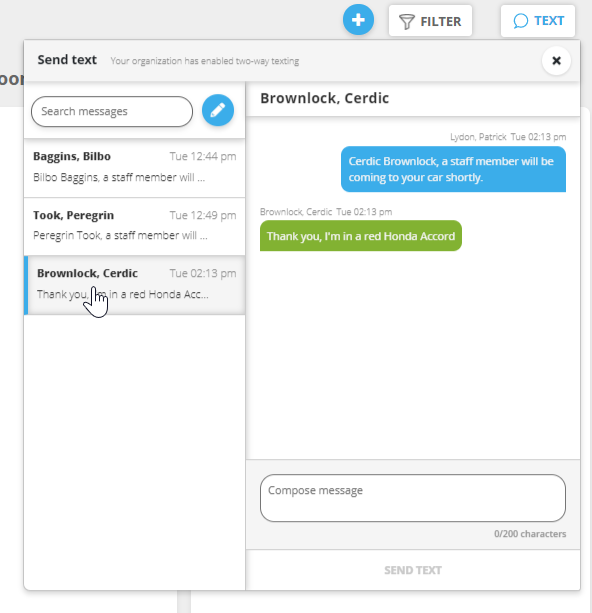
MedNow, a 7-location urgent care + primary care practice led by Mark Newton, M.D., deployed the MedChat triage bot combined with ER Express’ online scheduling solution to screen and book patients for telehealth visits and COVID-19 testing.
“We have long made it a top priority to deliver high-quality, timely, and efficient care. MedChat along with ER Express allows MedNow Urgent Care to stay at the forefront of respecting our patients’ valuable time,” said Newton, practicing ER physician and founder & CEO of MedNow. 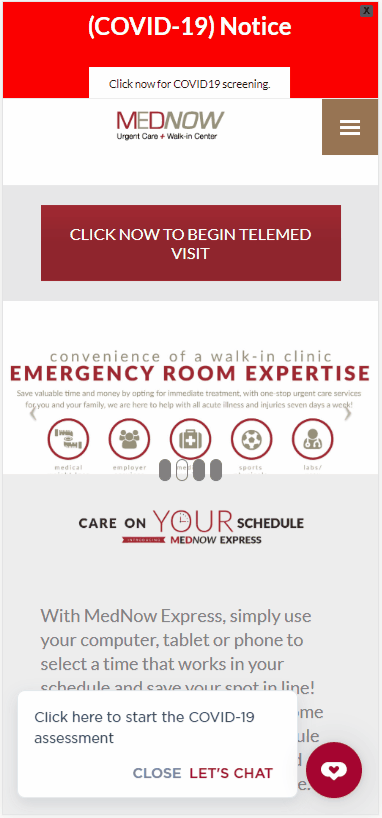
“When the county asked us to provide COVID-19 testing, we needed a way to screen and prioritize patients,” said Newton. “Our scheduling partner ER Express brought the MedChat triage bot to our attention. In just a few hours, we launched the triage bot tailored to our telehealth workflow.”
The triage bot screens patients to determine their individual level of risk based on Centers for Disease Control criteria. Medium- and high-risk patients are routed to schedule a telehealth screening through ER Express’ queueing software and, if appropriate, prioritized for testing. Patients with severe symptoms are triaged to nearby emergency departments. All patients can opt for a telehealth visit no matter their risk.
“Members of our communities want a way to know if they should be concerned for their health,” added Dr. Newton. “Offering the triage bot assessment reassures low risk individuals. The full protocol of triage bot, telehealth encounter and in-person testing maximizes the number of patients we can serve. As the protocol evolves, MedChat’s platform makes it very easy to change the bot’s screening criteria. We can now better deliver care to the patients who most need to talk to a provider and get tested. Like almost all counties, the demand for testing exceeds our capacity to test them all at once.”
In the first week, more than 600 patients screened themselves – many during off-hours. In the first weekend, more than 60% of high-risk patients scheduled a telehealth consult.
MedChat helps physician practices and other providers screen and triage patients quickly. Prior to the COVID-19 outbreak, practices primarily deployed MedChat to improve call response times, simplify scheduling, respond to billing questions, and handle other common patient inquiries. The chatbot and live chat platform became immediately useful for COVID-19 response because screening criteria and triage rules can be quickly adjusted as clinical guidance changes.
“We were already working with MedChat to deploy Schedule Bots for urgent care and emergency departments,” said Sahil Patel, founder & CEO of ER Express. “When COVID-19 hit, our clients asked for ways to assess patients, facilitate telehealth workflows and handle growing call volume, we immediately thought of MedChat. We are now deploying MedChat with several clients to triage patients, enable staff to work from home and alleviate the flood of inbound phone calls.”
“Won’t patients in my lobby get mad when someone checks in at home and then shows up in the lobby?”
Many health systems face a psychological barrier to offering online check-in: “I know the patients who use it will love the convenience. But I’m afraid it will make all of my other patients mad because they think someone skipped the line.”
Our display board technology, which shows all patients in the lobby their place in line, now comes pre-loaded with a promotional ad that rotates in every 10 seconds.
This pre-installed ad:
This ad educates your patients on where they can find the online check-in option, helping to spread the word on its convenience. It also helps reduce the anxiety that walk-in patients may feel when they hear or see a patient enter the waiting room and announce “I made an online reservation.” It helps manage patient expectations and reduce the perception that other patients “skipped the line.”
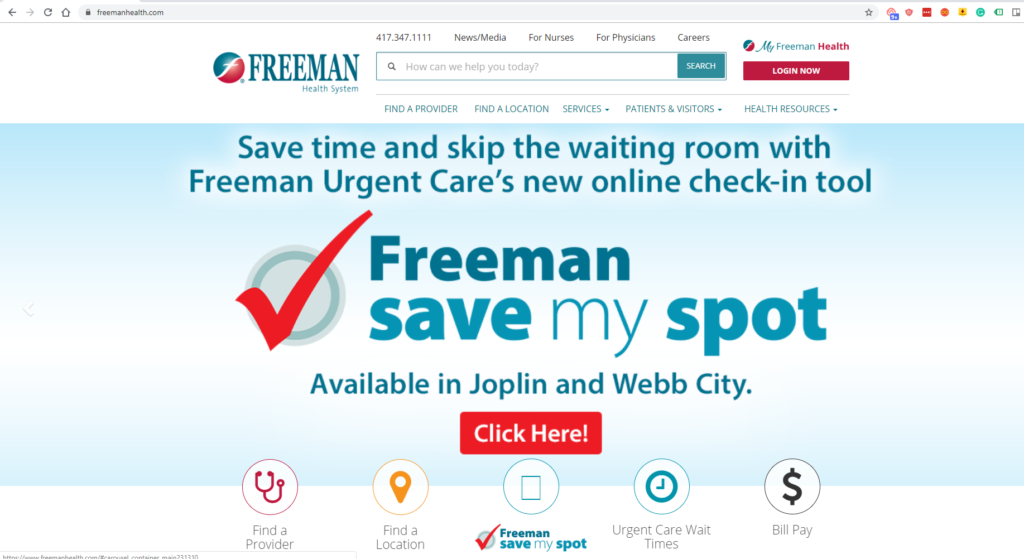
Home page banner + fixed Save My Spot button
Missouri-based Freeman Health recently implemented online check-in and digital patient queuing in two of their urgent care clinics. Freeman’s ‘Save My Spot’ strategy aimed to reduce wait times and bring in new patient volume. The queuing system automates patient expectations and gives staff much better control over influencing patient arrival patterns by throttling down time slots during their busiest hours and opening up slots during typically slower parts of the day.
Delivering new patient volume
Freeman Urgent Care Director Kayla Martinez summarizes the appeal of Save My Spot for her patients as something akin to “…call ahead seating at a restaurant, you can get your name in line and then do your waiting at home or in your office.”* Patients can plan out their visit at the time of day most convenient for them and avoid sitting in a waiting room when they’re not feeling well with other patients who may have contagious illnesses such as flu.
Patients immediately caught on to this idea. In the first two months:
Doubling the % of 5-star Google reviews
Freeman has also seen an immediate uptick in positive Google reviews. Patients consistently praised the convenience of the service. ER Express’ reputation management feature elicits patient feedback via SMS text and then prompts the happiest patients to share their feedback on Google. Good reviews based on the convenience of the service, as well as the use of our built-in text survey which prompts the happiest patients to leave their feedback on the Google for the facility they visited, have started rolling in as well. Case in point, Freeman Urgent Care at Webb City received three new 5-star Google reviews in a 24-hour period following the online check-in go-live. Summary of the stats**:
Here’s a preview of the good things patients had to say:
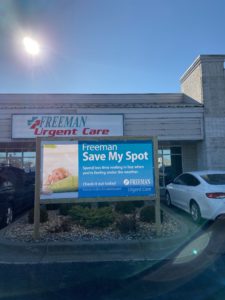
Save My Spot banner outside an urgent care


Getting the word out: digital marketing + local news + traditional signage
Freeman’s marketing team launched a very effective campaign to publicize Save My Spot in its community by combining digital promotion, local news reach and street side signage.
The full embrace by Freeman’s operational and clinical leaders combined with a savvy marketing campaign points to future increases in new patient volume, 5-star Google reviews, and overall usage of the online check-in service.
*Source: Koam News Now
**As of 2/19/2020; based n patient reviews posted for Freeman’s Webb City clinic
In today’s fast-paced healthcare landscape, people expect instant gratification and streamlined processes. Patients want to receive quality care without waiting for hours in crowded waiting rooms, and that’s where patient queuing automation comes into play.
Patient queuing automation is the use of technology to manage patient queues in healthcare settings. By automating the patient queuing process, clinics and hospitals can reduce wait times, improve patient satisfaction, optimize the use of resources, and ensure better patient safety. It’s a win-win situation for healthcare providers and patients alike.
In the past, healthcare organizations relied on paper-based systems and manual processes to manage patient queues. These methods were inefficient and often led to long wait times, confusion, and frustration for patients. With the advancement of technology, clinics and hospitals have found ways to improve the patient experience by automating the patient queuing process.
One of the most notable benefits of patient queuing automation is the significant improvement in patient satisfaction. No one likes to wait for hours in a crowded waiting room, and automated patient queuing systems help to mitigate this problem by prioritizing patients based on their urgency and notifying them when their turn is approaching. By reducing the time patients spend waiting, they can receive timely care and leave the clinic feeling satisfied with their experience.
Another critical benefit of patient queuing automation is a more efficient use of resources. Automated patient queuing systems help clinics optimize the use of their resources by allocating staff efficiently and reducing idle time. This, in turn, increases the number of patients served without increasing staffing costs, resulting in improved clinic operations and revenue.
Thirdly, patient queuing automation reduces the administrative burden of managing patient queues. With automated systems, the process of scheduling appointments, managing wait times, and notifying patients of any changes in their appointments becomes streamlined. The staff can focus more on patient care, and patients receive timely updates about their appointments, leading to greater convenience and satisfaction.
Automated systems ensure that patients are seen in the correct order, reducing the risk of errors and oversights. Medical history and information are accurately recorded and updated, and patients can receive more personalized care. These processes ensure that everyone receives equal attention, protecting your operational accuracy and your facility’s reputation with its local customer base.
Lastly, patient queuing automation provides valuable data that can be used to improve the quality of care. Clinics can identify trends, monitor patient flow, and improve the efficiency of clinic operations. By collecting and analyzing data, urgent care decision-makers can enhance the patient experience and optimize their operations.
Several technologies can be used to automate the patient queuing process, such as:
Choosing the right patient queuing automation solution is critical for urgent cares. Not all systems are created equal, and each healthcare facility has its own unique needs and requirements. Here are some important factors to consider when selecting the right patient queuing automation solution for an urgent care clinic:
At ER Express, we designed our digital patient queuing solution with both your staff’s and your patients’ experiences in mind. From low-contact access to digitized sign-ins, automated text communications, and more, you can better set and manage expectations at your urgent care with confidence that you can more effectively stabilize capacity and workload at your facility.
To learn more, schedule a demo with us today.
Addressing the challenges associated with patient flow in urgent care is a common need, but also a crucial priority for efficient service delivery and the overall patient experience. While the volume of patient requests is generally beyond the control of urgent care facilities, administrators possess the power to implement strategies that streamline patient flow, from check-in to check-out.
Today, we will outline some of the most common patient flow obstacles and explore some practical solutions to enhance efficiency and patient satisfaction within the urgent care environment. Let’s start with the unpredictability of patient volume.
One of the most significant patient flow challenges in urgent care is the unpredictability of patient volume. Unanticipated surges can put immense pressure on resources, leading to overworked staff and disgruntled patients. Without enough staff on-hand during peak hours, patients may leave the waiting room before being seen or simply decide not to check-in.
Solution: Incorporate Advanced Analytics and Forecasting
Implementing an advanced data analytics system can provide the insights that you need to accurately schedule your team at your facility to manage patient flow. Analytics can help predict patient volume based on historical data, local events, or even weather patterns. Accurate forecasting also aids in staffing adjustments to meet demand and ensures adequate resource allocation, thereby reducing wait times and improving patient throughput.
Communication breakdowns can lead to bottlenecks in patient flow. Whether it’s between different departments or between the staff and patients, a lack of clear communication can significantly hamper efficiency.
Solution: Implement Coordinated Communication Systems
Efficient communication systems are integral to streamlined patient flow. Integrated technology like Electronic Health Records (EHRs) can foster better coordination between departments. Similarly, communication tools that update patients about their wait times or the next steps in their care can enhance transparency and patient satisfaction.
A well-managed triage process is essential for urgent care facilities due to the varying urgency of patient needs. An ineffective triage system can lead to inefficiencies and potential compromises in patient care.
Solution: Streamline the Triage Process
Implementing a robust, algorithm-based triage system can ensure patients are promptly seen according to their medical urgency. Moreover, continuous staff training on the system can ensure its optimal utilization, facilitating effective patient flow.
Lengthy check-in and check-out procedures can slow down patient flow, cause congestion, and lead to dissatisfaction.
Solution: Digitize Check-In and Check-Out Processes
Digitizing these processes can drastically cut down time, thus accelerating the movement of patients throughout the cycle of a visit. Self-service kiosks or mobile forms for check-in, automated payment systems, and digital discharge instructions can make these processes faster and more patient-friendly.
An inadequate follow-up system can impact the overall patient experience and possibly lead to return visits, adding to the patient flow.
Solution: Enhance Follow-Up Procedures
Consider implementing a systematic approach to follow-ups using automated patient engagement systems like SMS messaging and automated email. These systems can send reminders for follow-up appointments or medication refills, reducing the possibility of unnecessary return visits.
While patient flow management in urgent care comes with its unique set of challenges, innovative strategies, and the right tools can significantly enhance efficiency and patient satisfaction. Administrators have the potential to turn these challenges into opportunities for improvement. A focus on forecasting, communication, triage efficiency, digitization, and robust follow-ups can ensure smoother patient journeys, ultimately driving the success of the urgent care facility.
If you are looking to enhance the way that your own urgent care manages the flow of patients, request a demo with our team at ER Express today to learn more about how our software solutions can be used to provide a better experience for your patients while reducing administrative burden on your staff at the same time.
We are excited to announce that ER Express is now fully integrated with ezyVet! This powerful collaboration streamlines your practice management by seamlessly connecting ER Express’s online check-in and digital intake tools with ezyVet’s comprehensive veterinary software. Request a demo today to see how this integration can elevate your clinic’s efficiency and enhance the overall experience for your staff and clients.

Enter your name and email below to discover how you can meet a growing demand and improve pet owner satisfaction.
© ER Express. All rights reserved.